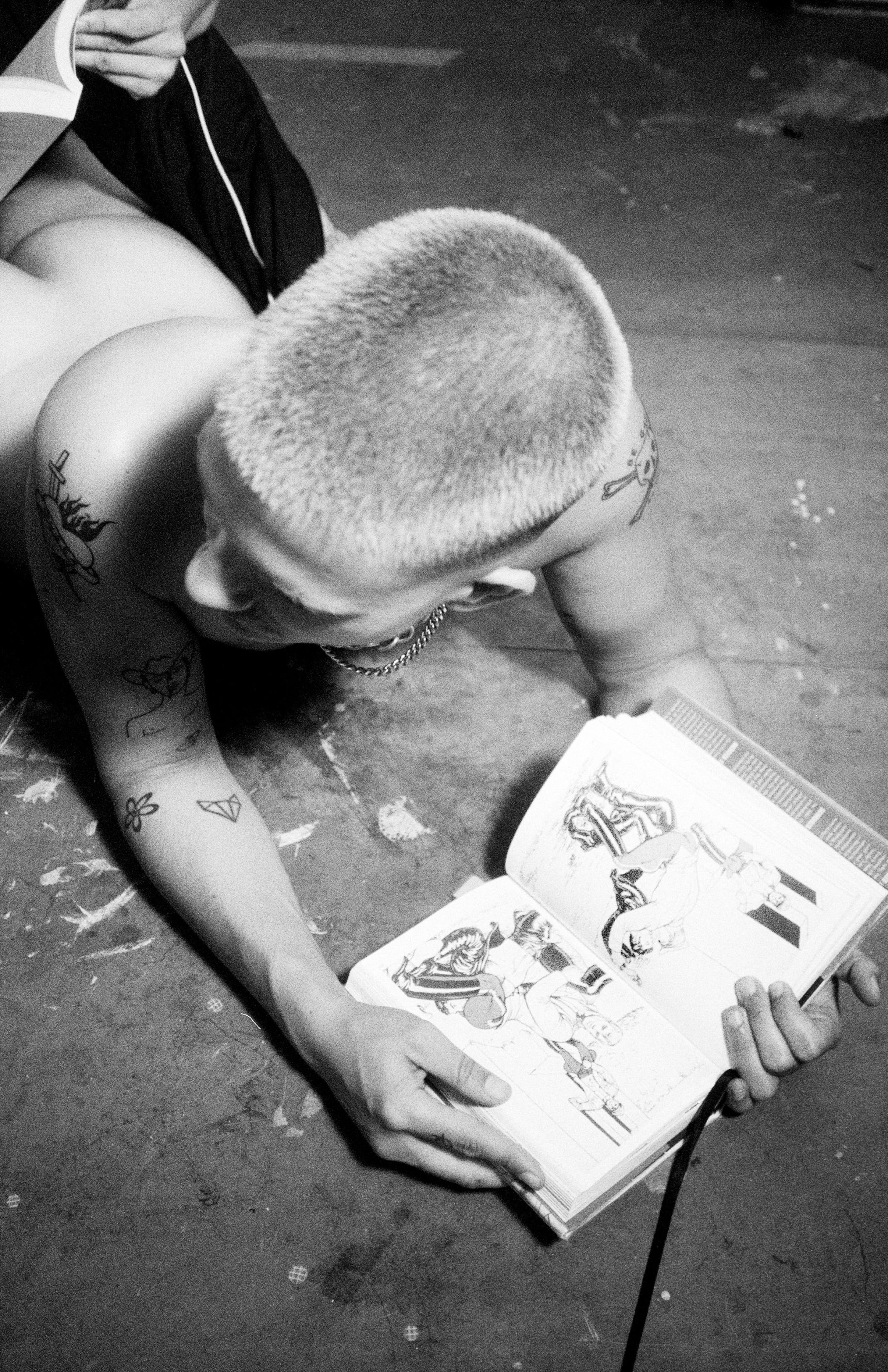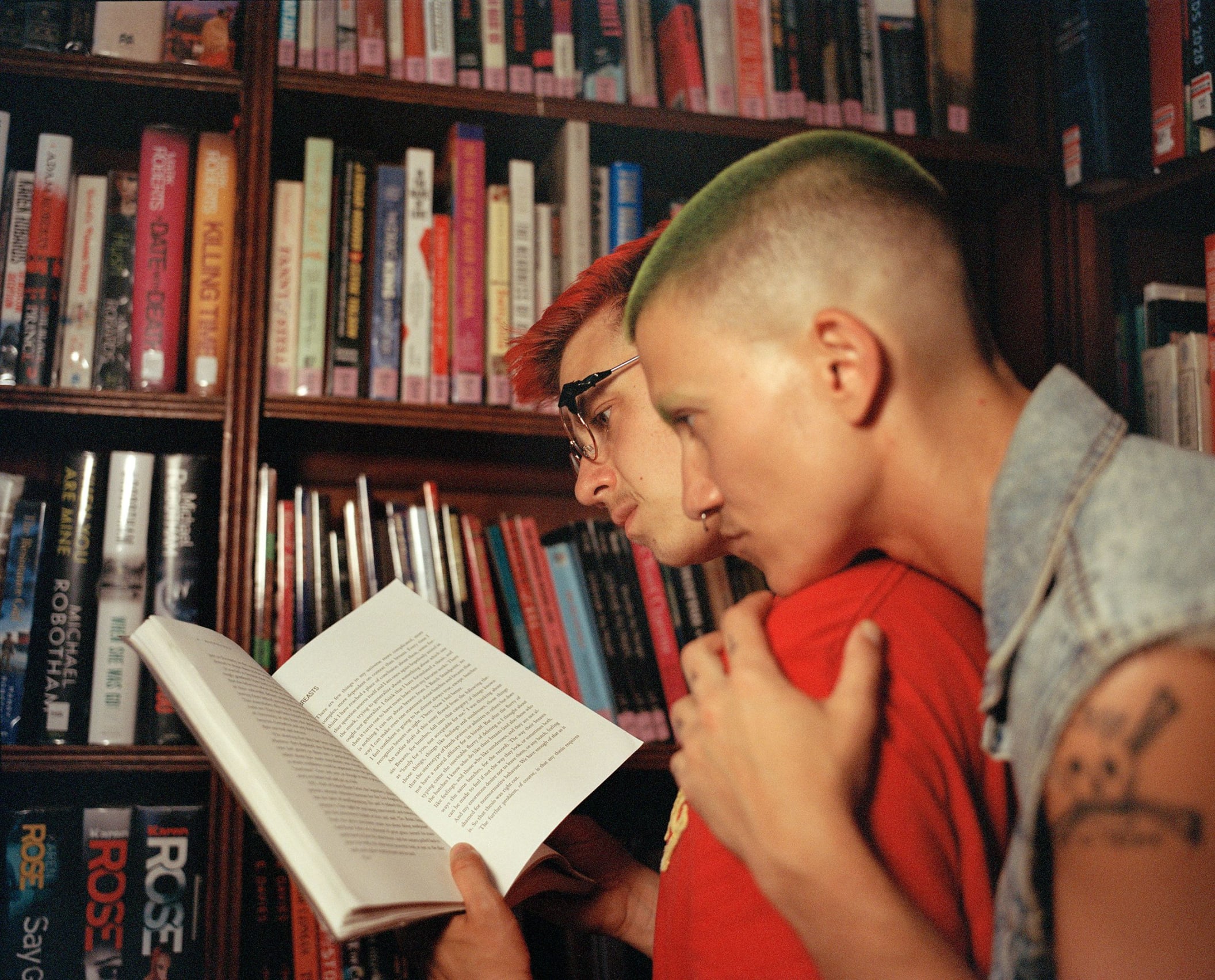Queer photography explores the erotic allure of the library
New exhibition 'Between the Stacks', showing at LGBTQIA+ barbers Toppins, delves into Section 28, gentrification and the intimate nature of reading
New exhibition 'Between the Stacks', showing at LGBTQIA+ barbers Toppins, delves into Section 28, gentrification and the intimate nature of reading
Whether it's sexy but buttoned-up librarians or the promise of getting busy between the book shelves, the library holds endless erotic appeal. This, at least, is what art show Between the Stacks takes as its central theme.
The collaborative exhibition between photographer Lydia Garnett, writer D Mortimer and artist and performer Prinx Silver was made in response to Mortimer and Silver being evicted from their studio space above a Hackney library. But despite the misfortune that prompted the show's creation, the trio have responded with their tongue firmly in cheek. Naughty and mischievous, the images by Garnett depict Mortimer and Silver frolicking between the stacks, locked in a queer embrace and engaging in a cheeky (in more ways than one) communal reading session.
Thematically, there's plenty to dive into as well. Whether it's the role of queer books in education and consciousness-raising or the ever-dwindling number of LGBTQIA+ spaces as gentrification rips through major cities, the show gestures at the tacit political and economic forces which restrict and police queer artistic creation.
Below, woo catches up with Mortimer - who also contributed text work and the exhibition text - to discuss the exhibition’s wide-ranging references across Section 28, Sunil Gupta and Tom of Finland, the unusual setting of queer barbers Toppins and what, exactly, makes reading so damn sexy.
How did this exhibition come about? What inspired the concept?
I don’t know if you’d call it inspiration as such but there was definitely an emotional catalyst, I was pissed off! Silver (who appears in the photographs) and I, as well as Maz Murray who also shared with us, were kicked out of our studio above a public library in Hackney with almost no notice and no opportunity for appeal or dialogue. The reason being? The library had received multiple anonymous phone calls reporting that the caller could see us in the studio up to no good, and suggesting that we may be sleeping in there and even having sex in the studio. We were the only artists asked to leave out of a floor of 5 studios, and our studio was all trans and queer.
The whole thing stunk and I wanted to respond in a positive, creative way so I enlisted the help of the amazing photographer Lydia Garnett who took the project to the next level and in a covert, very quickly cobbled together shoot we shot some portraits in the empty studio and the library downstairs. My thinking at the time was ‘If they think we’re fucking in the studio, let's give them fucking in the studio!’


What were some of the aesthetic and cultural references which fed into the images?
My main inspirations which I shared with Lydia were Tom of Finland’s Kake comics and Sunil Gupta’s 1988 portrait series "Pretended" Family Relationships which is a response to Section 28, which famously emptied library stacks of any mention of queers. We all wanted to make a steamy, fun piece of work. But it's also about needing affordable spaces as queer artists to make work and also the erotic power and pleasure of physically sharing space and reading radical texts collectively.
What makes reading so sexy?
I don’t think I can answer that for everyone. But I find reading sexy. There is something in the attentiveness and concentration afforded by the reader to the text that is unquestionably intimate. So there is the act of reading, and the text itself. I’m not sure how sexy it is reading the Radio Times. But when I am very involved in a novel, that passion and interest and obsession is not unlike a process of falling in love or lust. Also you take books to bed... I could really go into this and the symbiotic relationship between reader and text but I’ll leave it here. But I do think we read other people, we try and understand other people, lovers, friends, ourselves, and a novel gives you the opportunity to get inside another person's head… If you’re into that, it can be quite attractive.


Do you have a favourite LGBTQIA+ book? What makes it so special?
I am not sure I can answer this! But I can tell you the books that have made me feel really really excited in the last couple of years. These have been: Hildegard of Bingen and Huw Lemmey's Unknown Language, Lauren John Joseph’s At Certain Points We Touch and Isabel Waidner’s Sterling Karat Gold. Poetry and essay-wise, anything by Jay Bernard or Aisha Mirza. And the book I tell everyone to read is The Virosexuals by Orion J. Facey which is the perfect antidote to the Instagramification of trans discourse. It is exceptional.
In the exhibition text and above, you mention how the shadows of Section 28 can be felt in this work. Can you expand on this?
It seemed really clear to me that no work by queers set in a library could avoid the shadow of Section 28. There’s a poster upstairs in the studio loos from the eighties about safer sex. And every time I borrowed a book from the LGBT section I would feel kind of lucky to be able to do it given that so many titles were censored for so long you know. Tom of Finland, who I wrote a text about for the exhibition, felt like the strongest visual representation of what the tories were actively censoring from schools and libraries, the possibility of happy, casual anal sex. The fact these comics are held in Stoke Newington Library for public consumption feels pretty special to me after everything.
Additionally, you make reference to the artist's studio and the library, and the ways these types of spaces are both under threat from developers. How do you think these two spaces speak to each other?
There is the familiar cycle of gentrification - inhospitable building, artists studio, artists studio with caff, caff, Sainsburys below posh flats. The unique thing about our studio was that it was in a council-run building and a supposedly secure public institution - the public library. But as our experience shows, neither the library nor the studio are protected from the vampyric developers.
Libraries are being turned into heat hubs for people unable to afford their gas and electricity. In many ways they are needed now, more than ever but their status as repositories of free knowledge is under threat from a hostile government that famously gives zero tosses about protecting queer archives and accessible resources.
Fine buildings in sought-after postcodes are always game for poachers. This is what makes the artists studio and the library comparable. Without affordable space to play, dream, work and write in, we are impoverishing our queer cultural production. Right now the desk from my studio is rotting in the garden outside my house as I had nowhere to store it after we got kicked out. If you want a better metaphor for the death of queer space to create in this city, I don't think there is one.
As a final question, the exhibition is shown in a queer barbers, rather than a gallery. What is to be gained from showing queer work in non-traditional, queer-centric art spaces like this?
To be honest, I think space in this city is a premium and a privilege. It was literally like, 'Oh we know someone who can host it! In a barbers, Incredible.' And Lydia (Garnett) had done their exhibition Close Shave in the venue before, which was a massive success.
Of course, there is an indelible queerness about the barber shop, and Zara (Toppins, the barber shop's founder) hosts in inimitable style. Those leather chairs are gorgeous. I think if we could have hosted somewhere with full wheelchair access we would have. But it was special to have the readings outside, under the stars, on opening night. Zara is having to leave the space because of soaring rents so the exhibition takes on further meaning there.
Between The Stacks is a collaboration between photographer Lydia Garnett, writer D Mortimer and artist and performer Prinx Silver, hosted by Zara Toppin at the iconic Toppins queer hair salon.
You can check out the exhibition until Feb 24, booking by appointment here. You can also buy a Between The Stacks zine here, featuring two stories by D Mortimer and photographs by Lydia Garnett.



